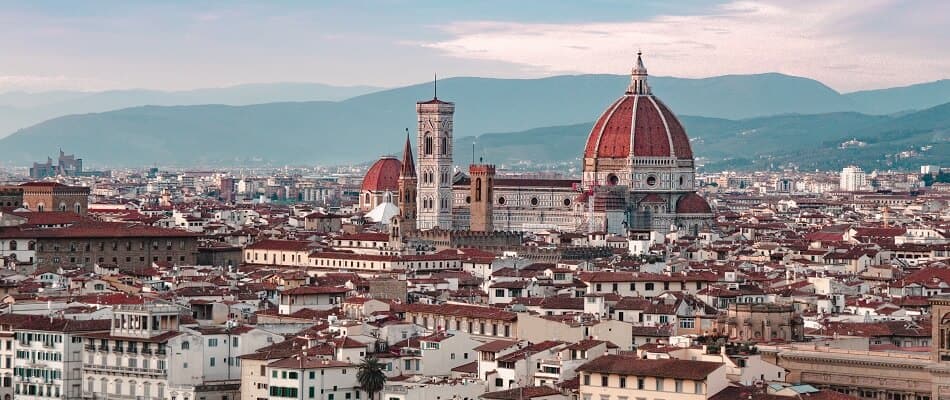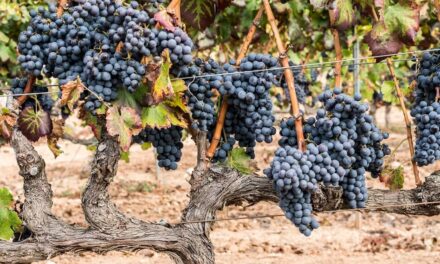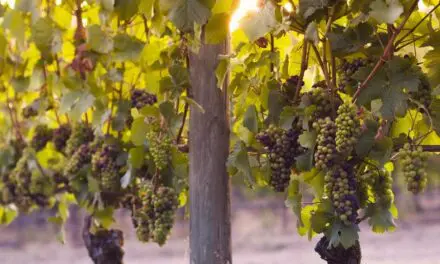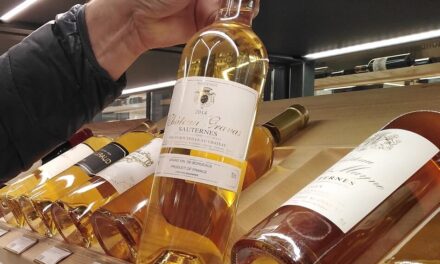Super Tuscan wines are red wines from Tuscany that do not meet the requirements for carrying the Chianti label. The reason is typically the use of non-indigenous grapes. The wines are dry, full-bodied, high in tannins, and feature fruity, spicy, and smoky aromas.
As there are so many great wines from Tuscany, it is worth discussing how they differ. And, of course, we should talk about how to find the best Super Tuscans and how to enjoy them. Let’s get into it.
WHAT IS SUPER TUSCAN WINE MADE FROM?
The main varietal for many Super Tuscan wines is Sangiovese. The red grape is native to Tuscany, and the first documentation of its use in winemaking goes back to the 16th century. The vines are very adaptable to different terroirs, but they need a long warm ripening season to develop their full flavor.
Besides, Super Tuscan varietals include Canaiolo Nero, Colorino, and other grapes native to Italy, but also international varietals such as Cabernet Sauvignon, Cabernet France, Merlot, or Syrah.
While many wines are blends made from two or more of these grapes, some winemakers produce single-varietal wines.
WHERE DO SUPER TUSCANS COME FROM?
Super Tuscan wines come from the Tuscany region in Central Italy. With its limestone soils, the high number of sunshine days, and a good amount of rain, the area bordering the Tyrrhenian Sea (a part of the Mediterranean Sea) provides optimal conditions for growing grapes. Logically, you can find many other fantastic wines coming from Tuscany. Among them are Chianti, Brunello di Montalcino, or the dessert wine Vin Santo.
SUPER TUSCAN HISTORY
Tuscany has a rich history in terms of culture and trade. You have probably heard (or maybe even seen) the Leaning Tower of Pisa, the Medieval town of San Gimignano, or the city of Florence with its beautiful Renaissance buildings.

Florence, Tuscany, Italy
But Tuscany is also known for its wines. It is home to the famous Chianti wines and became the world’s first officially regulated wine region in 1716. In 1872, the rules for making Chiantis were further formalized, naming Sangiovese as its main varietal and a small number of indigenous grapes as potential add-ons.
Chianti and Chianti Classico have been Tuscany’s signature wines since. But not all winemakers from the region appreciated the strict production rules these wines are subject to. They resisted especially the need to use only indigenous grapes and the prohibition of pure Sangiovese wines.
In the late 1960s, Incisa della Rocchetta, a vintner from the town of Bolgheri, decided to waive the restrictions and the right to carry the prestigious DOCG label. Instead of using Sangiovese grapes, he went for Cabernet Sauvignon and Cabernet Franc. His efforts resulted in a rich, high-quality red wine, similar to red Bordeaux. In 2013, this wine called Sassicaia even got its own independent DOC appellation.
Inspired by the success, other winemakers started using non-indigenous grapes and created several variations. They blended international varieties with the local Sangiovese grape, made single-varietal wines, and experimented with extensive oak aging.
The umbrella term Super Tuscans came up in the 1980s. Burt Anderson, an American wine and food writer, was the first to use this name. And as it was much easier to pronounce than the complicated Italian brand names, it quickly made its way into the international wine-lover community.
Another essential step in Super Tuscans’ history was the recognition as an IGT appellation. While the “Indicazione Geografica Tipica” is the lowest of Italian wine quality categories, it gave the wines a new level of legitimacy nevertheless.
In the last decades, some rules for making Chianti have been softened. Nowadays, it is allowed to use international grapes, so some Super Tuscan wines would qualify to use the Chianti label. Nevertheless, most vintners refuse to do it and stick to their original names.
SUPER TUSCAN EXAMPLES
Legally, there is no specific definition of a Super Tuscan wine. Most wine lovers put high-quality red wines into this category if they do not qualify as Chianti or another DOC wine. Here are some of the most famous brands:
- Sassicaia is considered the first of all Super Tuscans and made it to retailers’ shelves in 1968. It contains only Cabernet Sauvignon and Cabernet Franc.
- Tignanello is made from Cabernet Sauvignon, Cabernet Franc, and Sangiovese and ages in French oak barrels for several years. The first vintage was released in 1974.
- Ornellaia, a blend of Cabernet Sauvignon, Cabernet Franc, Merlot, and Petit Verdot, was first bottled in 1985.
- Masseto is a pure Merlot wine that was introduced to the market in 1986. It is inspired by Pomerol wines from Bordeaux.
- Flaccianello della Pieve comes from the Chianti Classico territory but doesn’t carry the DOCG label. It is a pure Sangiovese wine and spends 24 months in oak barrels before bottling.
- Bolgheri wines such as Guado al Tasso are Bordeaux-style blends, typically made from Cabernet Sauvignon, Cabernet Franc, and Merlot. The first bottles were sold in 1990. At the time, the producers used Syrah instead of Carbernet Franc, but in 2006, they altered their recipe.
What Is the Difference Between Super Tuscan and Chianti?
While both wines can be similar in style and taste, they differ in legal aspects.
Chianti is a strictly regulated red wine from the Chianti appellation in Tuscany. It is made from at least 70% Sangiovese grapes.
Super Tuscans come from Tuscany, too, but there are many communes outside the Chianti appellation where they are produced. Vintners have more freedom to experiment with different varietals. In particular, they can use smaller portions of Sangiovese grapes or waive the native varietal entirely.
Super Tuscan vs. Bordeaux
Some Super Tuscans tend to be just like Bordeaux wines. And actually, many Tuscan vintners get their inspiration from their French colleagues. For instance, they use the same varietals, such as Cabernet Sauvignon, Merlot, and Cabernet Franc, to make their wines. So it is common to find wines from both regions that are bold, tannic, and full of fruit flavors.
However, not all Tuscany wines fall into this category. Especially single-varietal wines can differ significantly from Bordeaux red wines.
Super Tuscan vs. Barolo
Super Tuscans can be very similar to Barolo wines in terms of their characteristics. Both are dry, bold red wines with high alcohol and tannin levels and intense fruity aromas.
Like Chianti, Barolo is subject to strict regulations. Only grapes from 11 communes in the Barolo appellation in Piedmont are allowed, and they have to grow on south-facing hillsides. Vintners are also limited regarding the yield per hectare of vines, minimum oak aging, and other aspects of the winemaking process. As a result, Barolo wines are considered the best Italian wines.
The production of Tuscany’s reds is less regulated, and winemakers have more options for composing their wines. While many are high-quality wines, only very few can compete with Barolos.
HOW TO SERVE A SUPER TUSCAN?
Super Tuscans are great with a rich main course. But you must take care of the serving temperature and the glassware to optimize the drinking experience.
What Is the Right Serving Temperature for Super Tuscan Wines?
The right serving temperature depends on the exact style: Most wines are best when you enjoy them at 60 to 65°F (15 – 18°C). Pick the upper end of this range for bolder styles, including Bordeaux-like blends. For lighter variations, such as pure Merlot wines, better go for the lower end of the range.
What Is the Right Glass to Serve Super Tuscans?
The best approach in terms of glassware is a glass with a big bowl. These glasses allow the wine to breathe and rise to its full potential. If you have a Bordeaux glass, that’s just perfect. But other red wine glasses will work as well.
Should You Decant Super Tuscan Wines?
Bold reds from the Tuscany region do need some aeration. Give them one to two hours in the decanter to release all of their aromas. Especially mature high-tannic wines benefit from this contact with oxygen.
SUPER TUSCAN FOOD PAIRING
Because of the variety of Super Tuscans, you can find a great wine pairing for almost any dish. Here are some of the best Super Tuscan and food pairings:
- If you serve a hearty meat dish, such as grilled beef, pork, or veal, go for a Sassicaia. Its high acidity is perfect for dealing with fatty cuts, and its fruity aromas complement a rich sauce perfectly.
- Pairing seafood and Tuscany red wines is possible, too, given the meal is not too light. Swordfish is a good choice, especially when prepared with intense spices and herbs like garlic or onions. Make sure your wine is not too bold; otherwise, it will overpower the fish.
- In case, you are going for a vegetarian meal, you need some bold ingredients, too. Mushrooms are fine, and the same is true for grilled vegetables like eggplant, artichokes, bell peppers, or cauliflower. Merlot-based wines are the right match for these meals.
- Super Tuscan wines are also great with cheese, particularly salty Italian hard cheeses.
SUPER TUSCANS SHOPPING
Finding Super Tuscans can be challenging because they do not belong to a unique, distinguishable appellation. However, some indicators help you find them:
- First, make sure you are looking for wines from Tuscany. Bottles from other regions do not qualify as Super Tuscans.
- In some online shops, the bold reds from Tuscany are categorized as “red Bordeaux blends” or “Bordeaux-style blends”.
- Many wines have names ending with “aia”, meaning “plot of vacant land”. For example, the name “Sassicaia” comes from the Italian word “sassi” (English: stones) and refers to a plot of land with many rocks. There are many other examples with similar names, so if you spot the suffix “aia” on a bottle label, it is likely a Super Tuscan.
- Some of the most iconic wines might be hard to find in the United States. If you are looking for a good one, search for Bolgheri wines. They are available in many online stores and will give you a good impression of high-quality Super Tuscans.
Why Are Super Tuscans So Expensive?
Many Super Tuscans, especially high-quality wines, are produced in small quantities. Thus, the demand typically exceeds the supply so that vintners can charge premium prices for their wines.
FINAL WORDS
Super Tuscans might not have the same reputation as Barolo or Chianti, but nevertheless, you can find fantastic wines belonging to this category. And with the freedom that vintners have to make them, you likely will find a style that matches your taste. Good luck and enjoy!






